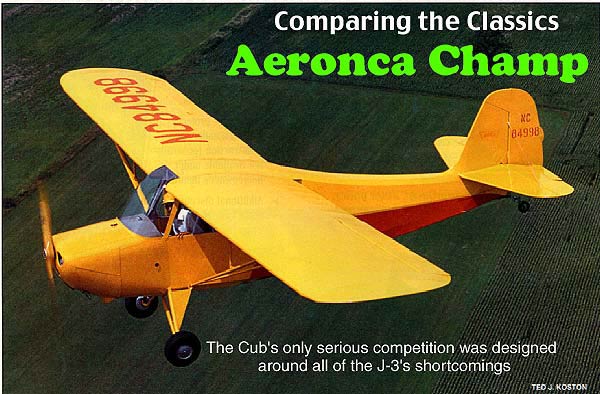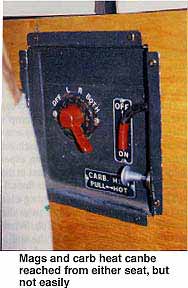

When it comes to picking their favorite post-war trainer, most folks fall into line behind one of two airplanes: The Cub or the Champ. Both have their supporters and detractors, but all will admit that the little Aeronca Champ is the only classic of the period to give the Cub a run for its money in the learning-to-fly game.
The first lines for the new airplane, the Model 7 Champion, were laid on vellum early in 1944 and the airplane flew in May of that year. Chief test pilot Louis Wehrung did the honors. The official designation of the airplane was 7AC (Model 7, first variation, Champion) and it used the A-65 Continental.
In laying out the configuration of the Champ, designer Ray Hermes took square aim at his primary competition, the J-3 Cub, which by that time, was nearly a decade old. He made a list of every one of the Cub's shortcomings and designed them out of his new airplane. The final lines of the Champ are the net result of Anti-Cub design goals.
 |
Forward visibility had always been a Cub weak point and Hermes solved that in two ways. First, he put the pilot in the front seat and, second, he raised the seating position and dropped the nose so the pilot could see straight ahead while on the ground. This is why a Champ appears so high in the cabin, when compared to the Cub. The Cub may have finer, sleeker lines, but the Champ pilot can not only see where he's going but sits up in real comfort (relatively speaking).
Cubs also came in for criticism in the drafty arrangement of the door. While the split door may be perfect for viewing sunsets today, when the Cub was working for a living, instructors and students alike cursed the leaky doors. The Champion used a hinged, single-piece door not unlike an automobile.
A little over 8,100 Champs were produced, most of which were the 65 hp 7ACs which ended production in April of 1948 to be replaced by the 85 hp 7BCM (it was fuel injected and had a larger dorsal fin, as well) which was ordered by the military as the L-16A. The military then went to 90 hp (fuel injected) and the nearest civilian counterpart was the 7CCM. The most common civilian version to come out of all of this was a combination of the A and B model L-16, the 85 hp 7DC which had the larger dorsal and an additional fuel tank in the right wing. Only 166 7DC's were built before the final Champ was introduced, the 90 hp 7EC. The final Champ rolled off the Aeronca line in January of 1951. It was Champ 7EC, SN96, N4749E. Anyone know where it is today?
A good design has a way of surviving and the 7EC is one of those. In 1954, Champion Aircraft of Osceola, Wisconsin, put the 7EC back into production where it continued to be up-graded, eventually becoming the 7ECA Citabria in the early 1960's.
 |
Mechanical Description
Champs use the triangular aft-fuselage Gene Roche originally designed for his little C-2 in the late 1920s. Because most Champs have probably spent more time tied down outside than in hangars, the plywood formers which fair the fuselage into a square shape have to be considered suspect. Bad fuselage wood isn't a major safety concern but it takes time and money to replace it.
Other than being triangular in cross section, there is little about a Champ's fuselage structure that presents unique inspection concerns. All steel tube fuselages share the same corrosion concerns, especially in the rear of the fuselage and in the strut carry-through tube under the floor.
The trim system is something else that the designer worked at to make more efficient than that on a Cub. When twisting the Cub trim crank, the stabilizer is being screwed up and down while the overhead knob in a Champ, which moves fore and aft in a slot, runs a trim tab on the elevator. The arrangement is quicker and easier, although, since it is located over the front pilot's left shoulder in the ceiling, it's a stretch to reach from the back seat.
To absorb landing shocks, the Champ uses an oleo-spring arrangement in the front leg of the landing gear "V" frame rather than bungees. In speaking with Buzz Wagner of the International Aeronca Association, he said the landing gear is the area in which they see the most problems, mostly because people don't maintain them or don't understand the system. The system is designed to use exactly eight and a half ounces of fluid. Let it get a half an ounce down and the gear will be damaged. According to Wagner, the majority of Champs in operation need the landing gear rebuilt to one degree or another and the difference in ground handling, when all the worn parts are replaced, is significant.
 There were two different
oleo's installed, the original straight oleo, and the "no bounce"
oleo which came out of the military's desire for an airplane that could be dropped
from ridiculous heights without damage. The original oleo is less complicated
and easier to handle in a crosswind. Wagner, among others, has new and rebuilt
replacements for either.
There were two different
oleo's installed, the original straight oleo, and the "no bounce"
oleo which came out of the military's desire for an airplane that could be dropped
from ridiculous heights without damage. The original oleo is less complicated
and easier to handle in a crosswind. Wagner, among others, has new and rebuilt
replacements for either.
All Champs prior to the 1954 re-introduction of the 7EC used mechanical brakes. These brakes, if properly adjusted, work just fine. There are two distinct different types, the Van Sickle/Cleveland type which is a traditional drum and shoe set up where a rotating cam actuates them and the Goodyear which is a form of mechanical disk brake. In neither one is there no an adjustment to move the shoes or pads closer to the drums to compensate for wear, as in a car. This is a weakness in the design and adjusting the cable tighter (most mechanics' initial urge) won't help. All that does is rotate the cam closer to its limits. Wagner says, if shoe brakes are no longer holding, replace the shoes. In the caliper brakes, replace the pads, and if they still don't hold, have the cam built back to its original dimension by welding.
 The post-1954 American Champion 7EC's used hydraulic drum brakes
which eliminates most of the problems. Fortunately, none of the
brake types are expensive to rebuild.
The post-1954 American Champion 7EC's used hydraulic drum brakes
which eliminates most of the problems. Fortunately, none of the
brake types are expensive to rebuild.
The wings are a combination of wood spars and formed-aluminum ribs. There is no rib stitching, as with most fabric airplanes, as the fabric is screwed or pop-riveted to the ribs. Generally speaking, Champ wings give little or no trouble.
The wing struts are welded closed which makes them less susceptible to rust than some others. Rust, however, is still a definite concern and they should be carefully inspected as per FAA guide lines. The end fittings are welded bushings, not adjustable forks, so there is no concern in that area.
For lots more pilot reports like this one go to PILOT REPORTS.